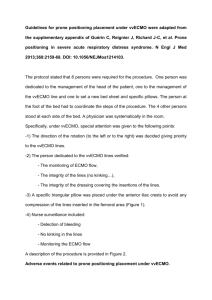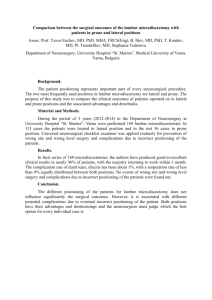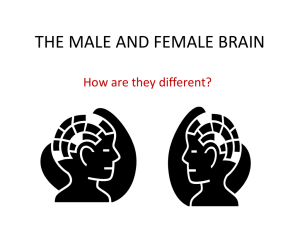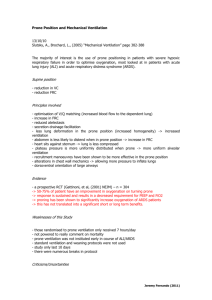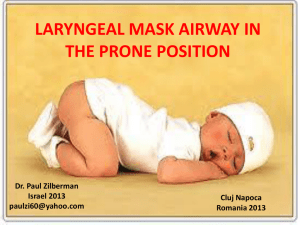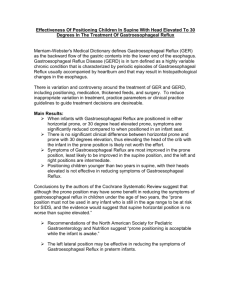Slide 1 - University of Michigan Health System
advertisement
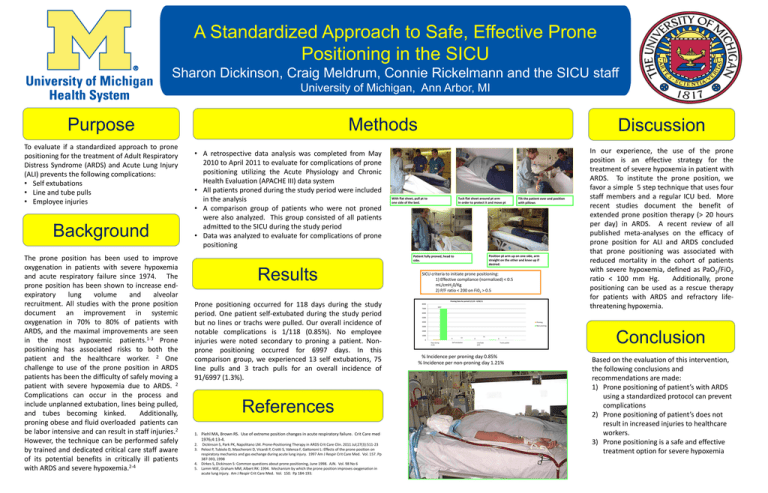
A Standardized Approach to Safe, Effective Prone Positioning in the SICU Sharon Dickinson, Craig Meldrum, Connie Rickelmann and the SICU staff University of Michigan, Ann Arbor, MI Purpose To evaluate if a standardized approach to prone positioning for the treatment of Adult Respiratory Distress Syndrome (ARDS) and Acute Lung Injury (ALI) prevents the following complications: • Self extubations • Line and tube pulls • Employee injuries Background The prone position has been used to improve oxygenation in patients with severe hypoxemia and acute respiratory failure since 1974. The prone position has been shown to increase endexpiratory lung volume and alveolar recruitment. All studies with the prone position document an improvement in systemic oxygenation in 70% to 80% of patients with ARDS, and the maximal improvements are seen in the most hypoxemic patients.1-3 Prone positioning has associated risks to both the patient and the healthcare worker. 2 One challenge to use of the prone position in ARDS patients has been the difficulty of safely moving a patient with severe hypoxemia due to ARDS. 2 Complications can occur in the process and include unplanned extubation, lines being pulled, and tubes becoming kinked. Additionally, proning obese and fluid overloaded patients can be labor intensive and can result in staff injuries.2 However, the technique can be performed safely by trained and dedicated critical care staff aware of its potential benefits in critically ill patients with ARDS and severe hypoxemia.2-4 Methods • A retrospective data analysis was completed from May 2010 to April 2011 to evaluate for complications of prone positioning utilizing the Acute Physiology and Chronic Health Evaluation (APACHE III) data system • All patients proned during the study period were included in the analysis • A comparison group of patients who were not proned were also analyzed. This group consisted of all patients admitted to the SICU during the study period • Data was analyzed to evaluate for complications of prone positioning Discussion With flat sheet, pull pt to one side of the bed. Tuck flat sheet around pt arm In order to protect it and move pt Position pt arm up on one side, arm straight on the other and knee up if desired. Patient fully proned, head to side. Results Prone positioning occurred for 118 days during the study period. One patient self-extubated during the study period but no lines or trachs were pulled. Our overall incidence of notable complications is 1/118 (0.85%). No employee injuries were noted secondary to proning a patient. Nonprone positioning occurred for 6997 days. In this comparison group, we experienced 13 self extubations, 75 line pulls and 3 trach pulls for an overall incidence of 91/6997 (1.3%). References 1. Piehl MA, Brown RS. Use of extreme position changes in acute respiratory failure. Crit Care med 1976;4:13-4. 2. Dickinson S, Park PK, Napolitano LM. Prone-Positioning Therapy in ARDS Crit Care Clin. 2011 Jul;27(3):511-23 3. Pelosi P, Tubiolo D, Mascheroni D, Vicardi P, Crotti S, Valenza F, Gattononi L: Effects of the prone position on respiratory mechanics and gas exchange during acute lung injury. 1997 Am J Respir Crit Care Med. Vol. 157. Pp 387-393, 1998 4. Dirkes S, Dickinson S: Common questions about prone positioning, June 1998. AJN. Vol. 98 No 6 5. Lamm WJE, Graham MM, Albert RK: 1994. Mechanism by which the prone position improves oxygenation in acute lung injury. Am J Respir Crit Care Med. Vol. 150. Pp 184-193. Tilt the patient over and position with pillows SICU criteria to initiate prone positioning: 1) Effective compliance (normalized) < 0.5 mL/cmH20/Kg 2) P/F ratio < 200 on Fi02 > 0.5 Proning Data for period 5/1/10 - 4/30/11 8000 7000 6997 In our experience, the use of the prone position is an effective strategy for the treatment of severe hypoxemia in patient with ARDS. To institute the prone position, we favor a simple 5 step technique that uses four staff members and a regular ICU bed. More recent studies document the benefit of extended prone position therapy (> 20 hours per day) in ARDS. A recent review of all published meta-analyses on the efficacy of prone position for ALI and ARDS concluded that prone positioning was associated with reduced mortality in the cohort of patients with severe hypoxemia, defined as PaO2/FiO2 ratio < 100 mm Hg. Additionally, prone positioning can be used as a rescue therapy for patients with ARDS and refractory lifethreatening hypoxemia. 6000 5000 4000 Proning 3000 Non-proning 2000 1000 0 0 Days during study 13 Self-extubation 75 0 3 0 Line/tube pulls Trachs pulled % Incidence per proning day 0.85% % Incidence per non-proning day 1.21% Conclusion Based on the evaluation of this intervention, the following conclusions and recommendations are made: 1) Prone positioning of patient’s with ARDS using a standardized protocol can prevent complications 2) Prone positioning of patient’s does not result in increased injuries to healthcare workers. 3) Prone positioning is a safe and effective treatment option for severe hypoxemia
